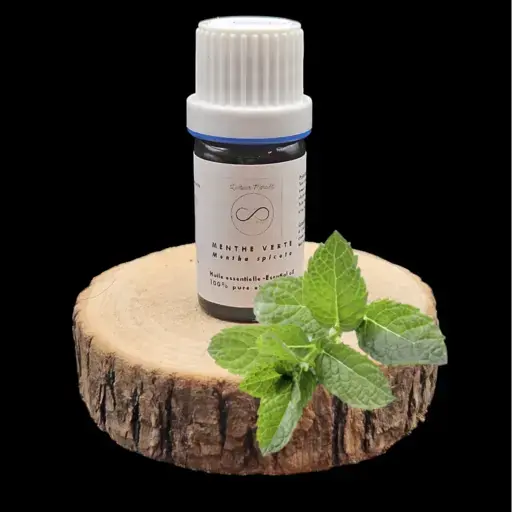Spearmint essential oil
Botanical name: Mentha spicata
Distilled part: Flowering plant
Botanical family: Lamiaceae
Origin: Morocco
Chemical composition:
-Ketones: Carvone (55 to 65%), Menthone, Pulegone
- Esters
- Menthofuran (52%)
- Monoterpenes: Alpha and Beta Pinene, Alpha Phellandrene, Camphene, Limonene (8.75 to 20%), -, Myrcene
- Monoterpenols: Linalool, Borneol, Menthol, Trans Thuyanol 4
- Oxides: 1.8 Cineole,
- Sesquiterpenes: Alpha Elémène, Beta Bourbonene, Beta Caryophyllene, Farnesene
- Sesquiterpenols: Cadinol, Elémol, Farnésol
Hazard: Abortifacient; Neurotoxic; Do not use during homeopathic treatment; Internal use sparingly; Possible allergic reactions, prefer external use; Prohibited for pregnant women; babies; children
Legend: * powerful,** very powerful;*** extremely powerful (power value for the associated pathology)
PHYSICAL PROPERTIES AND THERAPEUTIC INDICATIONS:
Anti-inflammatory*
Acute bronchitis*
Chronic bronchitis*
CNS calming
Catarrh
Mucopurulent catarrh*
Cholagogue
Choleretic*
Healing
Cystitis
Expectorant*
Fatigue
Mucolytic*
Wound*
Bile stimulant*
Digestive stimulant*
EMOTIONAL, PSYCHIC PROPERTIES AND THERAPEUTIC INDICATIONS:
Emotional shock
Stimulating
Stress
Concentration (favors)
Weariness
Memory (lack)
Nervousness
Reference and bibliographic source: Lily BAYER and Dr Hervé STAUB, (2013) “In-depth treatise on Phyto and Aromatherapy”, Ed. Grancher. p. 587.
INDICATIONS IN AROMATHERAPY AND THE USE OF ESSENTIAL OILS DO NOT CONSTITUTE A MEDICAL DIAGNOSIS AND DO NOT REPLACE THE ADVICE OF A DOCTOR OR MEDICAL TREATMENT!





